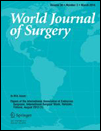Cure Predictability During Parathyroidectomy
Abstract
Background
A mathematical model for primary hyperparathyroidism (1°HPTH) was developed and embedded in software to yield intraoperative predictability curves.
Methods
A total of 1,754 consecutive 1°HPTH operative cases were screened to select 617 [554 single adenoma (SA), 63 multigland] patients with complete preoperative, intraoperative (pre-exploration, time 0, every 5 min post-resection), and postoperative parathyroid hormone (PTH) and calcium data. Data transformations and models were hypothesized and tested, including inverse functions, differences, half-lives, differences from projected half-lives, second-order kinetics, second-order derivatives, and time-dependent ratios. Sub-models of ratios were developed for time-dependent and initial-value combinations. For each time segment the log odds were modeled using multiple logistic stepwise regression. An idealized model was selected, embedded in software, and installed in a laptop computer to enable intraoperative decision analyses, PTH curve plotting, and storage and transmission of data. A subsequent cohort of 100 consecutive unselected patients [81 SAs, 19 multigland (13 hyperplasia, 2 MEN1, 1 lithium, 3 double adenomas)] inclusive of seven remedial cervical explorations were tested.
Results
The model predicted an overall curative resection in 95 % of patients. In SA patients, cure was predicted in 78/81 patients with a mean probability of 99.3 % at 11.8 ± 10.4 min post-resection. In three cured patients, the software failed to suggest cure, because of a low baseline PTH or delayed clearance. The model also correctly predicted residual hyperfunctioning tissue in all tested multigland patients. All multigland patients underwent additional exploration with resection of residual disease resulting in a mean predicted cure rate of 97.9 % at 10.6 ± 7.3 min post-resection completion in 17 patients. In two patients, the software predicted a mean cure rate of 22 % due to either a low PTH baseline or delayed clearance. Overall, the software accurately predicted cure in 95 of 100 cured cases.
Conclusions
This intraoperative prediction software expedites termination of surgery with a high level of curative confidence. Alternatively, the model accurately predicts residual disease prompting additional exploration. Because the model is based on a large set of multivariate regression curves, PTH values obtained at any post-resection sampling interval generate prediction data with far greater accuracy than existing algorithms. The software is designed for convenient operative use and can print, store, and electronically transmit probability analyses and PTH curves in real-time.




